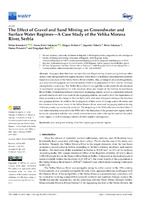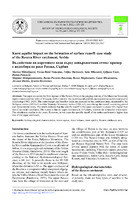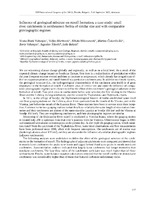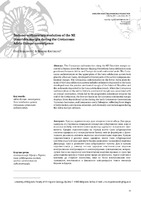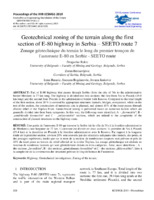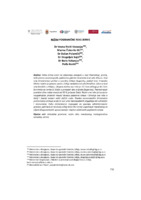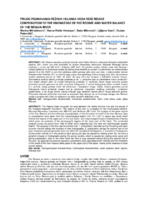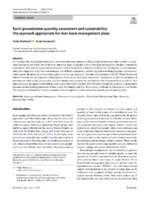Претрага
251 items
-
Dating of alluvial sediments from borehole at the lower course of the Sava river and indications of the connection between their genesis and climate changes in the Pleistocene
David Mitrinović, Jelena Zarić, Oliver Anđelković, Gyorgy Sipos, Dušan Polomčić, Milan Dimkić (2019)This paper analyses the way in which Pleistocene climate change and glaciations in Dinaric Mountains was reflected in the deposition of alluvial sediments in the Sava river Valley, using a case study of Belgrade Groundwater Source (BGS), the largest and most downstream alluvial water supply source along the Sava river. A stratigraphic analysis of the Quaternary sediments from two boreholes on this site, based on sediment dating, lithological members identification, grain size distribution analysis was performed. Comparison with the ...Pleistocene, Alluvial deposits, Climato-lithostratigraphy, Sava river, Belgrade groundwater source, LuminescenceDavid Mitrinović, Jelena Zarić, Oliver Anđelković, Gyorgy Sipos, Dušan Polomčić, Milan Dimkić. "Dating of alluvial sediments from borehole at the lower course of the Sava river and indications of the connection between their genesis and climate changes in the Pleistocene" in Quaternary International, Elsevier BV (2019). https://doi.org/10.1016/j.quaint.2019.09.028
-
Interpretacija gravimetrijskog reziduala i njena promjena u području Savske i Dunavske potoline
Željko Zagorac (1975)Željko Zagorac. Interpretacija gravimetrijskog reziduala i njena promjena u području Savske i Dunavske potoline, Zagreb:, 1975
-
Formiranje hidrogeoloških kolektora u donjem toku Save, kao "izvorišta" za vodosnabdevanje Beograda
Jordan Živković (1976)Jordan Živković. Formiranje hidrogeoloških kolektora u donjem toku Save, kao "izvorišta" za vodosnabdevanje Beograda, Beograd:Rudarsko Geološki Fakultet, 1976
-
Hidrogeološke karakteristike tercijarnih basena u Srbiji južno od Save i Dunava
Petar Dokmanović (1996)Petar Dokmanović. Hidrogeološke karakteristike tercijarnih basena u Srbiji južno od Save i Dunava, Beograd:Rudarsko Geološki Fakultet, 1996
-
Groundwater management by riverbank filtration and an infiltration channel, the case of Obrenovac, Serbia
Dušan Polomčić, Bojan Hajdin, Zoran Stevanović, Dragoljub Bajić, Katarina Hajdin. "Groundwater management by riverbank filtration and an infiltration channel, the case of Obrenovac, Serbia" in Hydrogeology Journal, Berlin, Heidelberg : Springer, International Association of Hydrogeologists (2013). https://doi.org/10.1007/s10040-013-1025-9
-
Assessment of river sediment quality according to the eu water framework directive in large river fluvial conditions. A case study in the lower Danube river basin
Atanas Hikov, Anca-Marina Vîjdea, Irena Peytcheva, Gyozo Jordan, Prvoslav Marjanović, Zlatka Milakovska, Petyo Filipov, Milena Vetseva, Albert Baltres, Veronica Elena Alexe, Lidia-Lenuța Bălan, Marko Marjanović, Vladica Cvetković, Kristina Šarić & The Simona Project Team (2023)Monitoring, uzorkovanje, hazardne supstance, teški metali, organske supstance, geološka osnova, standard kvaliteta životne sredine (EQS), basen reke DunavAtanas Hikov, Anca-Marina Vîjdea, Irena Peytcheva, Gyozo Jordan, Prvoslav Marjanović, Zlatka Milakovska, Petyo Filipov, Milena Vetseva, Albert Baltres, Veronica Elena Alexe, Lidia-Lenuța Bălan, Marko Marjanović, Vladica Cvetković, Kristina Šarić & The Simona Project Team. "Assessment of river sediment quality according to the eu water framework directive in large river fluvial conditions. A case study in the lower Danube river basin" in Carpathian Journal of Earth and Environmental Sciences (2023). https://doi.org/10.26471/cjees/2023/018/251
-
Impact of river bank filtration on alluvial groundwater quality: A case study of the Velika Morava River in central Serbia
Branislav Petrović, Vladimir Živanović (2016)филтрација кроз обалске и седименте речног корита, алувијални седименти, прихра- њивање подземних вода, квалитет подземних вода, Велика МораваBranislav Petrović, Vladimir Živanović. "Impact of river bank filtration on alluvial groundwater quality: A case study of the Velika Morava River in central Serbia" in Annales geologiques de la Peninsule balkanique, National Library of Serbia (2016). https://doi.org/10.2298/GABP1576085P
-
The use of biological markers in determination of origin and type of organic matter in the Tisza river sediments
Snežana Štrbac, Gordana Gajica, Aleksandra Šajnović, Nebojša Vasić, Ksenija Stojanović, Branimir Jovančićević (2013)The objective of the study was to determine the origin and type of organic matter (OM) of the Tisza recent sediments along the distance of 153 km through the territory of Serbia. For this purpose group organic-geochemical parameters and biomarker compositions were used. All samples contain approximately same amount of OM, which was deposited under uniform, slightly reducing conditions. Based on the distribution of n-alkanes, the origin and type of OM could not be precisely estimated. However, n-alkane patterns ...... Tisza River on the territory of Serbia (Fig. 1; Table I). These sites are located near Kanjiža Town (entrance area of the River from Hungary to Serbia) up to its confluence into the Danube. The length of this river section is 153 km and it covers almost the entire length of the Tisza River through ...
... Tisza River sediments, apart from immature singenetic organic matter, contain oil pollutants of anthropo- genic origin. The identical compositions of these biomarkers in all samples con- firmed that the recent sediments of the Tisza River, from Kanjiža Town to the confluence into the Danube River, contain ...
... forensic character. In this paper, the surface sediments of the Tisza River, in the part of river flow from Kanjiža Town to its confluence into the Danube, were investigated. Considering the navigable character of the Tisa River, and thus its exposure to _________________________________________ ...Snežana Štrbac, Gordana Gajica, Aleksandra Šajnović, Nebojša Vasić, Ksenija Stojanović, Branimir Jovančićević. "The use of biological markers in determination of origin and type of organic matter in the Tisza river sediments" in Journal of Serbian Chemical Society, Beograd : Srpsko hemijsko društvo (2013). https://doi.org/10.2298/JSC130614087S
-
Ecological status of the Lim river alluvium in Serbia
Amel Kurbegović, Boris Vakanjac, Vesna Ristić Vakanjac, Mirjana Bartula, Zorana Naunović, Nikola Milovanović, Jovan Kovačević (2022)Three countries share the catchment of the Lim River and they have been engaged in an eco-logical struggle for years, to conserve the river, its tributaries, and biodiversity. Honoring international conventions and declarations, along with active involvement of the civil society and support of Eu-ropean Union agencies, major efforts are being made to draw attention to the degradation of nature, especially water, which is essential for life on the planet Earth. Considering that natural resources are limited and that ...Amel Kurbegović, Boris Vakanjac, Vesna Ristić Vakanjac, Mirjana Bartula, Zorana Naunović, Nikola Milovanović, Jovan Kovačević. "Ecological status of the Lim river alluvium in Serbia" in Fresenius Environmental Bulletin, Parlar Scientific Publications (2022)
-
The Effect of Gravel and Sand Mining on Groundwater and Surface Water Regimes — A Case Study of the Velika Morava River, Serbia
Milan Kresojević, Vesna Ristić Vakanjac, Dragan Trifković, Jugoslav Nikolić, Boris Vakanjac, Dušan Polomčić, Dragoljub Bajić (2023)Овај рад описује како неконтролисано и нелегално откопавање песка и шљунка може утицати на режим површинских и подземних вода на местима где постоји активна хидрауличка веза између њих, са студијом случаја реке Велике Мораве у Србији. Такође, промена геометрије попречног профила, као последица антропогених и природних фактора, отежава уливање ове реке за укључивање у водне токове Србије. Плодност Велике Мораве омогућила би развој речног саобраћаја како за трговачке бродове, тако и за пловила Речне флотиле Војске Србије. Корелације између ...Milan Kresojević, Vesna Ristić Vakanjac, Dragan Trifković, Jugoslav Nikolić, Boris Vakanjac, Dušan Polomčić, Dragoljub Bajić. "The Effect of Gravel and Sand Mining on Groundwater and Surface Water Regimes — A Case Study of the Velika Morava River, Serbia" in Water, MDPI AG (2023). https://doi.org/10.3390/w15142654
-
Karst aquifer impact on the formation of surface runoff: case study of the Resava River catchment, Serbia
Marina Mitrašinović, Vesna Ristić Vakanjac, Veljko Marinović, Saša Milanović, Ljiljana Vasić, Dušan Polomčić (2022)The paper compares the flow regimes of the Resava River at the gauging stations of the Manasija Monastery (upper course) and the town of Svilajnac (lower course). The hydrological analysis encompasses a multiyear period of monitoring (1982–2020). The water budget and baseflow index are assessed for the catchment areas monitored by the Svilajnac station (683 km2) and the Manasija Monastery station (358k m2), considering the overall monitoring period and characteristic years. The results indicate that the specific runoff in ...... resulting values for the part ofthe catchment monitored by the gauging station at the Manasija Monastery show that the upper catchment ofthe Rc- sava River conveys 3.31 m*/s or 104 million cubic Year Gauging station Wl Weaenow (10* m*) Wiawano „ (10* m*) Baseflow index 1994 Manasija Mon. 55.597 38 ...
... karst terrain, and the rest is non- karst. The same applies to dry years but in that case the specific runoff in the upper catchment ofthe Re- sava River is twice the specific runoff in the entire catchment in the same dry ycar, or the arca covcred by the gauging station at Svilajnac. However, in ...
... Resava catchment is in the northern part of East- ern Serbia, between the Velika Morava River and the slopes of the Kučaj-Beljanica Mountains. The Resava River originates at the junction of the Zlots- ka River and the Karapandžin Creek at an altıtude of 668 m. It is a major right-side tributary ofthe ...Marina Mitrašinović, Vesna Ristić Vakanjac, Veljko Marinović, Saša Milanović, Ljiljana Vasić, Dušan Polomčić. "Karst aquifer impact on the formation of surface runoff: case study of the Resava River catchment, Serbia" in National Conference with International Participation “GEOSCIENCES 2022”, Sofia : Bulgarian geological society (2022)
-
Influence of geological substrate on runoff formation, a case study: small river catchments in southeastern Serbia of similar size and with comparable pluviographic regimes
Vesna Ristić Vakanjac, Veljko Marinović, Nikola Milovanović, Marina Čokorilo Ilić, Boris Vakanjac, Jugoslav Nikolić, Saša Bakrač (2022)We are witnessing climate change that is happening both, globally and, at the regionally - or local level. As a result of expected climate change in Southeast Europe, in the first place are the distributions of precipitation within the year (frequent extreme events are present) and then the increase in temperature, which already has a significant impact on evapotranspiration and runoff formed in a particular catchment area. In addition to climatic factors, the geological structure, i.e. the hydrogeological characteristics ...Vesna Ristić Vakanjac, Veljko Marinović, Nikola Milovanović, Marina Čokorilo Ilić, Boris Vakanjac, Jugoslav Nikolić, Saša Bakrač. "Influence of geological substrate on runoff formation, a case study: small river catchments in southeastern Serbia of similar size and with comparable pluviographic regimes" in XXII International Congress of the Carpathian Balkan Geological Association (CBGA), Sofia : Bulgarian Academy of Sciences (2022)
-
Tectono-sedimentary evolution of the NE Dinarides margin during the Cretaceous Adria-Europe convergence
Uroš Stojadinović, Nemanja Krstekanić (2023)Uroš Stojadinović, Nemanja Krstekanić. "Tectono-sedimentary evolution of the NE Dinarides margin during the Cretaceous Adria-Europe convergence" in Geološki anali Balkanskoga poluostrva (2023). https://doi.org/10.2298/GABP230112001S
-
Impact of river bank filtration on alluvial groundwater quality – a case study of the Velika Morava River in central Serbia
Petrović Branislav, Živanović Vladimir (2015)Petrović Branislav, Živanović Vladimir. "Impact of river bank filtration on alluvial groundwater quality – a case study of the Velika Morava River in central Serbia" in Geološki anali Balkanskog poluostrva, Beograd:Department of Historical and Dinamical Geology and Department of Paleontology, Faculty of Mining and Geology, University of Beolgrade (2015): 85-91. https://doi.org/10.2298/GABP1576085P
-
Geotechnical zoning of the terrain along the first section of E-80 highway in Serbia – SEETO route 7
Part of E-80 highway that passes through Serbia (from the city of Nis to the administrative border Merdare) is 77 km long. The highway is divided into two sections: the first from Nis to Plocnik (39.4 km long) and the second from Plocnik to the administrative border with Kosovo. The route is designed through a typical plain and hilly terrain in which different geological units are dominant: crystalline schists, neogene sediments of foothills and quaternary sediments in the valley ...... but alluvial and river-terraced planes are beyond the influence of the Toplica River flow, so they are stable. Potential instabilities are present in the zone of unregulated river banks, which can have significance during the construction of the bridge over the Toplica River, and less significance ...
... sediments in the valley of the Toplica River and its tributaries. Investigation results enabled the separation of three characteristic regions (Table 1). In the section 0-17.2 km, highway route crosses alluvial relief of the Toplica River tributaries and river terraces of smaller distribution ...
... muddy and saturated, but can be well drained. River-terraced plateaus are outside the influence of the Toplica River flow and they are completely stable. On this section, deluvial- proluvial structures are registered which are isolated in smaller river zones (Figure 3). Geotechnical zoning ...Dragoslav Rakić, Zoran Berisavljević, Irena Basarić, Snežana Bogdanović, Jovana Janković. "Geotechnical zoning of the terrain along the first section of E-80 highway in Serbia – SEETO route 7" in Proceedings of the XVII European Conference of Soil Mechanics and Geotechnical Engineering ECSMGE-2019, Reykjavik, Iceland, 1-6. 09. 2019., ISSMGE, ECSMGE-2019 (2019). https://doi.org/10.32075/17ECSMGE-2019-0393
-
Common barbel (Barbus barbus) as a bioindicator of surface river sediment pollution with Cu and Zn in three rivers of the Danube River Basin in Serbia.
Arian Morina, Filis Morina, Vesna Đikanović, Slađana Spasić, Jasmina Krpo-Ćetković, Bojan Kostić, Mirjana Lenhardt (2015)Arian Morina, Filis Morina, Vesna Đikanović, Slađana Spasić, Jasmina Krpo-Ćetković, Bojan Kostić, Mirjana Lenhardt. "Common barbel (Barbus barbus) as a bioindicator of surface river sediment pollution with Cu and Zn in three rivers of the Danube River Basin in Serbia." in Environmental Science And Pollution Research 23 no. 7, :Springer (2015): 6723-6734. https://doi.org/10.1007/s11356-015-5901-9
-
Režim pogranične reke Jerme
Vesna Ristić Vakanjac, Marina Čokorilo Ilić, Dušan Polomčić, Dragoljub Bajić, Boris Vakanjac, Peđa Kostić (2019)Reka Jerma izvire na Vlasinskoj visoravni u zoni Vlasinskog jezera, teče prema severozapadu padinama planine Gramade kroz selo Klisuru. Kod sela Strazimirovci prelazi u susednu državu Bugarsku, prolazi kroz Trnovsko ždrelo i zatim se ponovo vraća u Srbiju nedaleko od sela Petačinci. Uliva se kod sela Gradište u Nišavu. Ukupna dužina ove reke je 72.1 km od toga je 45.1 km formirala na teritoriji Srbije a preostali deo pripada Bugarskoj. Posmatrajući površine sliva nešto manje od 50 % pripada ...Vesna Ristić Vakanjac, Marina Čokorilo Ilić, Dušan Polomčić, Dragoljub Bajić, Boris Vakanjac, Peđa Kostić. "Režim pogranične reke Jerme" in Zbornik radova II Međunarodne naučne konferencije, Regionalni razvoj i prekogranična saradnja, Pirot, 2018., UO Privredna komora Pirot (2019)
-
Prilog poznavanju režima i bilansa voda reke Resave
Sliv Resave zauzima područje između reke Velike Morave i obronaka Kučajsko-beljaničkih planina. Sliv i režim ove reke kontroliše se dvema hidrološkim stanicama: Manastir Manasija (slivno područje u iznosu od 388 km2) i Svilajnac (681 km2). Za potrebe analize režima voda reke Resave i uticaja padavina na formiranje oticaja sa njenog sliva preuzeti su podaci o padavinama sa meteorološke stanice Crni Vrh (1037 m nm) koji odslikava režim gornjeg dela sliva ove reke, i meteorološke stanice Smederevska ...Marina Mitrašinović, Vesna Ristić Vakanjac, Saša Milanović, Ljiljana Vasić, Dušan Polomčić. "Prilog poznavanju režima i bilansa voda reke Resave" in Zbornik radova XVI Srpski hidrogeološki simpozijum sa međunarodnim učešćem, Zlatibor, 2022., Univerzitet u Beogradu, Rudarsko-geološki fakultet (2022)
-
Karst groundwater quantity assessment and sustainability: the approach appropriate for river basin management plans
Veljko Marinović, Zoran Stevanović (2019)As a result of the fact that karstified rocks can accumulate large amounts of high-quality groundwater, karst aquifer is considered, throughout the world, one of the most important types of aquifers. Due to their high permeability, but also vulnerability to pollution, these precious groundwater resources need to be properly evaluated and protected. Taking into account heterogeneity and complexity of the karst environment, it is difficult to propose a uniform algorithm for managing karst groundwater, which causes the necessity to ...Upravljanje karstnim podzemnim vodama, Pritisci na kvantitet voda, Plan upravljanja vodnim resursima, Bosna i Hercegovina, SrbijaVeljko Marinović, Zoran Stevanović. "Karst groundwater quantity assessment and sustainability: the approach appropriate for river basin management plans" in Environmental Earth Sciences, Springer Science and Business Media LLC (2019). https://doi.org/10.1007/s12665-019-8364-3
-
Transboundary groundwater resource management: needs for monitoring the Cijevna River Basin (Montenegro–Albania)
The transboundary Cijevna River Basin shared between Albania and Montenegro has a surface area of 650 km2. It is extremely important for water management, especially in the country of Montenegro which is downstream. Due to the high permeability of both the karst and intergranular aquifers that exist in the basin, the River Cijevna sinks along the length of its riverbed and in summer months it usually dries up completely at the confluence section. Hydrometry surveys undertaken during a drought ...Upravljanje međugraničnim vodama, ranjivost podzemnih voda, monitoring mreža, karstne izdani, Albanija, Crna GoraMomčilo Blagojević, Zoran Stevanović, Milan Radulović, Veljko Marinović, Branislav Petrović. "Transboundary groundwater resource management: needs for monitoring the Cijevna River Basin (Montenegro–Albania)" in Environmental Earth Sciences, Springer Science and Business Media LLC (2020). https://doi.org/10.1007/s12665-020-8809-8


